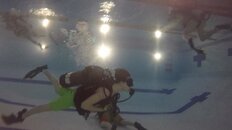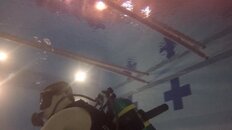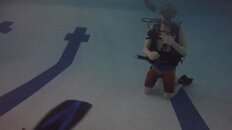Looks like you are indoors as you have the pool lights on, so light will be low. The images all look underexposed. The ones with the light in the frame, the go-pro likely reduced the exposure because of that, but in general looks like not a lot of light available? You might be able to improve things by shooting a lower frame rates like 24 FPS. I found an article about using a go-pro in low light:
The Absolute Best GoPro Low Light Settings [2018 Update] If you do this of course you need at be more careful of subject movement and be extra careful keeping the go-pro stable.
Also In the shallow water you may not need the red filter so try it without that - you may need to play with white balance settings a little. If you have the option to take photos rather than frame grab, you may find you can take the extra care to be stable for that one shot. What sort of housing do you have, does it use a dome or a flat port?







